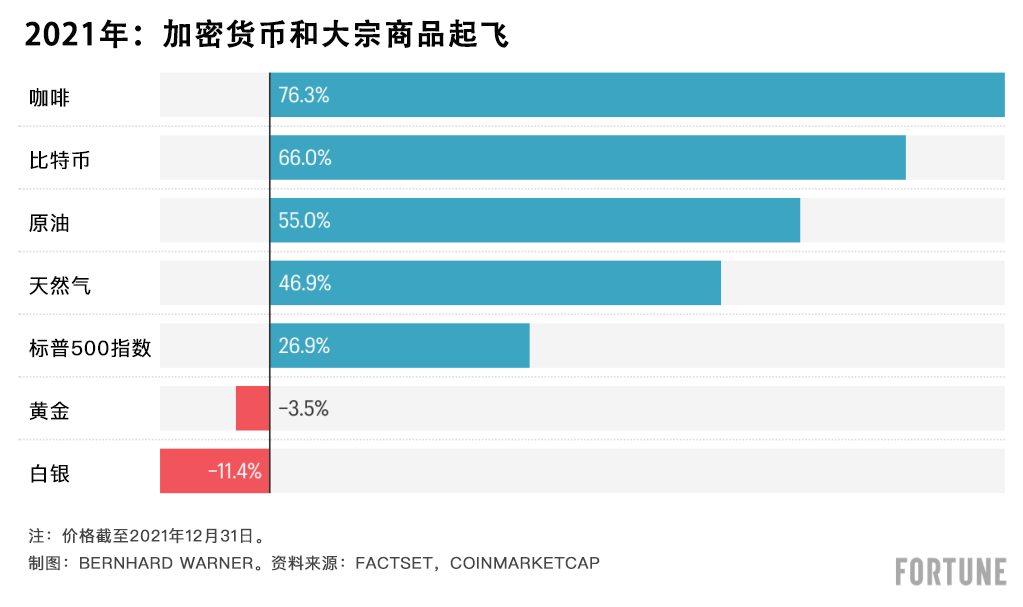对投资者来说,2021年的股市堪称精彩,标准普尔500指数(S&P 500)的年度涨幅在21世纪排名第三位。
留心的人们都知道,基准指数上涨了26.9%。受到能源、金融和大型科技股的推动,加上股息的话,标准普尔500指数的总回报率达28.7%。不过如果仔细研究数据,就会发现背后的贫富不均。
高盛集团(Goldman Sachs)发现,整整一年里,苹果(Apple)、微软(Microsoft)、英伟达(Nvidia)、特斯拉(Tesla)和Alphabet旗下的谷歌(Google)五只股票的回报占标准普尔总回报的32.6%。高盛警告称,市场如此狭窄往往意味着沉闷。换句话说就是:投资者倾向尽可能长时间跟着赢家走,却容易忽略市场上其他有希望的领域。
果然,年终数据充分显示出大型科技股对投资者投资组合的影响力。纳斯达克100指数(Nasdaq 100)上涨26.6%,标准普尔500指数的科技板块涨幅为33.4%。

再往东看,2021年股市情况就没有那么亮眼了。中国政府治理高增长科技股,再加上一系列数据显示全球第二大经济体增长开始放缓,所以中国股市受到影响。
加密货币、大宗商品和咖啡
要想找到2021年的大赢家,只看大宗商品和加密货币就够了。尽管2021年12月的比特币(Bitcoin)走势跌宕起伏,全年却仍然上涨了66%。而且在过去三年中,堪称另类货币之王的比特币的涨幅超过400%。但比特币想争夺2021年的回报最佳还差一点。因为该项荣誉归属低调的咖啡豆。受地缘政治、气候灾难和新冠疫情影响,过去一年的咖啡期货合约暴涨,2021年的涨幅达到惊人的76.3%。

展望2022年
虽然2021年的股市涨幅可观,但华尔街却几乎没有人预测2022年的大涨能够再现。高盛对标准普尔500指数的年终点位预期是5100点,比当前水平增长约7%。这一预测已经相当乐观。摩根士丹利(Morgan Stanley)的财富管理首席投资官丽萨·沙莱特表示,“预计标准普尔500指数将在区间内上下波动。”美银证券(BofA Securities)预计今年年底的标准普尔指数点位为4600点,意味着今年股市将下跌。
受一系列因素影响,未来一年市场前景愈加复杂。其中包括央行态度更加强硬、通胀加剧、供应链困境至少持续到2022年上半年,以及美国总统乔·拜登的“重建更好未来”(Build Back Better)刺激支出计划想要在美国国会通过还面临长期困难等等。
利率和减量
华尔街有越来越多的人认为,今年3月美联储(Federal Reserve)将结束资产购买,而且2022年上半年某个时候将提升基准贷款利率。传统情况下,此类环境中价值股(比如金融股)表现要比没有利润的成长股好一些。有些投资者已经意识到这点,开始拯救多只2020年代的成长型股票。
通货膨胀
2021年年底,通货膨胀开始升温。预计通胀至少持续到2022年上半年。供应链混乱应该有所缓解,不过随着企业着手应付极其紧缺的就业市场,劳动力成本上升料将持续。
这一情况必然会影响股市。高盛的美国首席股票策略师大卫·科斯汀直言:“2022年投资者应该关注高增长、高利润的股票,避开可能出现薪资通胀风险的公司。”
无法重建?
2022年年初,基础设施、消费者和气候相关股票可能坎坷不断,尤其当前拜登政府1.75万亿美元的支出闪电战似乎已经成为泡影。高盛就预期“重建更好未来”无法在美国国会通过。如果真如预期一样无法通过,就可能打击经济增长,因为向来是美国经济引擎的消费者没有足够的弹药来消费、消费、消费。2021年市场上最令人惊讶的力量之一,即大批散户投资者可能也会受影响。
新冠疫情
2021年11月,本就混乱的市场因为奥密克戎变异毒株而越发动荡。现在要预料该传染性超强的变异毒株对全球经济的影响有多严重,可能为时过早。然而企业纷纷被迫重新考虑开放的计划,航空公司取消了数以千计的航班。旅游和休闲股受创,大规模“重新开放”也增加了不确定性。最近,德意志银行(Deutsche Bank)在一份投资者报告中警告称,奥密克戎变异毒株将“增加短期阻力。”(财富中文网)
译者:冯丰
对投资者来说,2021年的股市堪称精彩,标准普尔500指数(S&P 500)的年度涨幅在21世纪排名第三位。
留心的人们都知道,基准指数上涨了26.9%。受到能源、金融和大型科技股的推动,加上股息的话,标准普尔500指数的总回报率达28.7%。不过如果仔细研究数据,就会发现背后的贫富不均。
高盛集团(Goldman Sachs)发现,整整一年里,苹果(Apple)、微软(Microsoft)、英伟达(Nvidia)、特斯拉(Tesla)和Alphabet旗下的谷歌(Google)五只股票的回报占标准普尔总回报的32.6%。高盛警告称,市场如此狭窄往往意味着沉闷。换句话说就是:投资者倾向尽可能长时间跟着赢家走,却容易忽略市场上其他有希望的领域。
果然,年终数据充分显示出大型科技股对投资者投资组合的影响力。纳斯达克100指数(Nasdaq 100)上涨26.6%,标准普尔500指数的科技板块涨幅为33.4%。
海外方面,2021年斯托克欧洲600指数(Stoxx Europe 600)上涨22.2%,超过纳斯达克(Nasdaq)和道琼斯工业指数(Dow Jones industrial average)。1月3日,欧洲股市开盘即上涨,各大前景良好的板块纷纷走高。不过在此需要警告:伦敦富时指数(FTSE)假期休市,成交量清淡;因此,不要对看似颇有希望的开门红过分解读。
再往东看,2021年股市情况就没有那么亮眼了。中国政府治理高增长科技股,再加上一系列数据显示全球第二大经济体增长开始放缓,所以中国股市受到影响。
加密货币、大宗商品和咖啡
要想找到2021年的大赢家,只看大宗商品和加密货币就够了。尽管2021年12月的比特币(Bitcoin)走势跌宕起伏,全年却仍然上涨了66%。而且在过去三年中,堪称另类货币之王的比特币的涨幅超过400%。但比特币想争夺2021年的回报最佳还差一点。因为该项荣誉归属低调的咖啡豆。受地缘政治、气候灾难和新冠疫情影响,过去一年的咖啡期货合约暴涨,2021年的涨幅达到惊人的76.3%。
展望2022年
虽然2021年的股市涨幅可观,但华尔街却几乎没有人预测2022年的大涨能够再现。高盛对标准普尔500指数的年终点位预期是5100点,比当前水平增长约7%。这一预测已经相当乐观。摩根士丹利(Morgan Stanley)的财富管理首席投资官丽萨·沙莱特表示,“预计标准普尔500指数将在区间内上下波动。”美银证券(BofA Securities)预计今年年底的标准普尔指数点位为4600点,意味着今年股市将下跌。
受一系列因素影响,未来一年市场前景愈加复杂。其中包括央行态度更加强硬、通胀加剧、供应链困境至少持续到2022年上半年,以及美国总统乔·拜登的“重建更好未来”(Build Back Better)刺激支出计划想要在美国国会通过还面临长期困难等等。
利率和减量
华尔街有越来越多的人认为,今年3月美联储(Federal Reserve)将结束资产购买,而且2022年上半年某个时候将提升基准贷款利率。传统情况下,此类环境中价值股(比如金融股)表现要比没有利润的成长股好一些。有些投资者已经意识到这点,开始拯救多只2020年代的成长型股票。
通货膨胀
2021年年底,通货膨胀开始升温。预计通胀至少持续到2022年上半年。供应链混乱应该有所缓解,不过随着企业着手应付极其紧缺的就业市场,劳动力成本上升料将持续。
这一情况必然会影响股市。高盛的美国首席股票策略师大卫·科斯汀直言:“2022年投资者应该关注高增长、高利润的股票,避开可能出现薪资通胀风险的公司。”
无法重建?
2022年年初,基础设施、消费者和气候相关股票可能坎坷不断,尤其当前拜登政府1.75万亿美元的支出闪电战似乎已经成为泡影。高盛就预期“重建更好未来”无法在美国国会通过。如果真如预期一样无法通过,就可能打击经济增长,因为向来是美国经济引擎的消费者没有足够的弹药来消费、消费、消费。2021年市场上最令人惊讶的力量之一,即大批散户投资者可能也会受影响。
新冠疫情
2021年11月,本就混乱的市场因为奥密克戎变异毒株而越发动荡。现在要预料该传染性超强的变异毒株对全球经济的影响有多严重,可能为时过早。然而企业纷纷被迫重新考虑开放的计划,航空公司取消了数以千计的航班。旅游和休闲股受创,大规模“重新开放”也增加了不确定性。最近,德意志银行(Deutsche Bank)在一份投资者报告中警告称,奥密克戎变异毒株将“增加短期阻力。”(财富中文网)
译者:冯丰
Last year was a banner year for investors, with the S&P 500 racking up its third-best yearly performance in the 21st century.
For those keeping score, the benchmark index climbed 26.9%. Add in dividends, and the S&P 500 total return was 28.7%, powered by energy, finance, and large-cap tech stocks. But a peek inside those numbers reveals a market of haves and have-nots.
For the full year, Goldman Sachs found that a batch of just five stocks—Apple, Microsoft, Nvidia, Tesla and Alphabet’s Google—delivered 32.6% of all S&P returns. Such narrow market breath tends to be a sticky phenomenon, Goldman warns. Translation: Investors tend to ride the winners as long as they can, neglecting other promising areas of the market.
Sure enough, the year-end numbers showed the power of Big Tech on investor portfolios. The Nasdaq 100 gained 26.6%, and the S&P 500 technology sector gained 33.4%.
Overseas, the Stoxx Europe 600 gained 22.2% last year, a performance that beat out both the Nasdaq and Dow Jones industrial average. European bourses on January 3 started the year in the green with every sector in positive territory out of the gates. The caveat: Trading volume is light with London’s FTSE closed for the holiday; so don’t read too much into the promising start.
Further east, it wasn’t nearly so pretty last year. Chinese stocks took a hammering as Beijing cracked down on high-growth tech stocks and a volley of data revealed growth in the world’s No. 2 economy is beginning to slow.
Crypto, commodities, and coffee
To find 2021’s big winners, one need look no further than commodities and crypto. Despite a choppy December, Bitcoin finished the year up 66%. And, the king of alt-coins is up more than 400% over the past three years. But it cannot quite take the crown for Best Return of 2021. That honor goes to the humble coffee bean. Thanks to geopolitics, climate havoc, and COVID, futures contracts on coffee have been skyrocketing for the past year, up an astounding 76.3% in 2021.
The year ahead
As impressive as last year was, few if any on Wall Street are predicting a repeat performance for 2022. Goldman Sachs’s year-end target for the S&P 500 is 5100, a roughly 7% gain from today’s level. That’s one of the more rosy forecasts. Morgan Stanley wealth management chief investment officer Lisa Shalett says, “We expect the S&P 500 to be range-bound and volatile.” And BofA Securities has a year-end 4600 handle on the S&P, which would mean stocks will go backward this year.
A whole swirl of factors are complicating market outlooks in the year to come. They include more hawkish central banks, elevated inflation, and supply chain woes lingering at least through the first half of 2022, and the long odds President Joe Biden faces in getting his Build Back Better stimulus spending plan to pass in Congress.
Interest rates and tapering
There is growing consensus on Wall Street that the Federal Reserve will wind down its asset purchases by March and begin raising the benchmark lending rate at some point in the first half of 2022. Traditionally, value stocks (think financials) outperform unprofitable growth stocks in such an environment. Sensing this, investors already began bailing on many of 2020’s growth-stock darlings.
Inflation
At the close of 2021, inflation was running hot. That’s expected to continue at least through the first part of 2022. Supply chain snarls should ease, but elevated labor costs are expected to linger as employers deal with the tightest job market in memory.
That reality is bound to impact stocks. Goldman Sachs chief U.S. equity strategist David Kostin bluntly advises that “for 2022, investors should focus on stocks with high growth and high margins and avoid firms with high exposure to wage inflation.”
Build Back Never?
Infrastructure-, consumer-, and climate-related stocks could be in for a bumpy ride in early 2022, particularly now that the Biden administration’s $1.75 trillion spending blitz looks dead in the water. Goldman Sachs, for one, is banking on Build Back Better dying in Congress. That presumed defeat will hit likely economic growth as the consumer, the engine of the U.S. economy, will have less firepower to spend, spend, spend. It’s also likely to put a damper on one of the most surprising forces of the 2021 markets: the flush retail investor.
COVID
Omicron added a fresh dose of volatility into already turbulent markets in November. It's still too early to say how severe an effect the highly infectious strain will have on the global economy. Already, companies are compelled to rethink reopening plans, and the airlines have been canceling flights by the thousands. That’s rocking travel and leisure stocks and adding uncertainty to the larger “reopening” trade. “Omicron,” Deutsche Bank warned in a recent investor note, will “add to near-term headwinds.”






